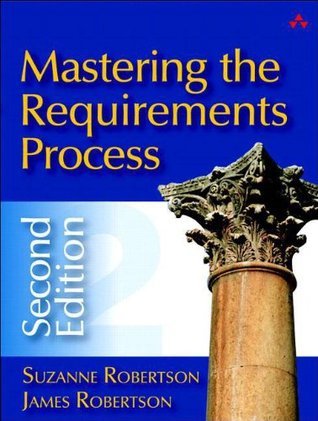What do you think?
Rate this book


560 pages, Hardcover
First published August 12, 1999
- Conscious requirements -which are the ones which are at the top of a stakeholder’s mind,In the same chapter they suggest applying some simple and effective neurolinguistic programming techniques to analyze and improve preliminary statements to turn them into more effective requirements. Sadly, these two topics are omitted from the fourth edition.
- Unconscious requirements, which can be thought of as embedded within implicit stakeholder knowledge, and
- Undreamed-of requirements, which are requirements that are possible but that stakeholders don’t realize are possible.
- Trawling for requirements (chapter 5) -except for the very poor section on Peter Checkland’s soft systems methodology;The authors use an interesting, and unusual, running example as a case study throughout the text -a software system to help plan, organize and supervise de-icing for winter roads. The example is, unfortunately, not very interesting for most tropical and subtropical countries in the world. In such countries, a far more serious, and somewhat related, problem de-icing roads is preparing drain-off waterways for the wet season when the dry season. At the end of the dry season, gullies, streams, and other runoff water channels may be clogged with leaves, trunks, and debris and require cleaning and dredging to prevent such channels from overflowing and flooding extensive rural and urban areas. Domains for such a problem include waterways, weather, scheduling, trucking, as well as dredging, draining, and water-bank maintenance teamwork. Unfortunately, in the fourth edition, the de-icing problem is downplayed, losing much of its charm and completeness, and a second running case study based on a (classic) and elementary library service disappears entirely.
- Scenarios and requirements (chapter 6), particularly its introductory coverage of negative and misuse scenarios.
- Functional requirements (chapter 7) and Nonfunctional requirements (chapter 8), which cover the essentials of these important topics and provide pointed and simple examples. In my opinion, the sections on social and political requirements are far too skimpy and completely miss the importance of coming up with value-driven, ethical nonfunctional requirements.
- Reviewing the specification (chapter 14). The authors define the project’s specification as its business and product use cases as well as its requirements, assumptions, and constraints. This chapter provides ideas on checking and analyzing the specification for completeness, consistency, and feasibility (and stakeholder value?). I particularly liked how the chapter shows how Fagan inspection techniques can be applied to the specification review -another topic which disappears from the fourth edition.
- Whither requirements? (chapter 15), which, among other things, convincingly argues for carrying out retrospectives on the requirements process.
To put those ideas in practice you can use the Volere template that is part of appendix A. With that template as a starting place you are reminded of all the different things you should think about. The template alone will not make your project a success, but with the structure it offers the chances are really good that you will have all the important points in your requirements document. And from there it’s much simpler to build the right thing.
If you don’t like the Volere process you still get a lot of good advice on the gathering of requirements. You may need to fill in some gaps to your process but that should not be too hard.